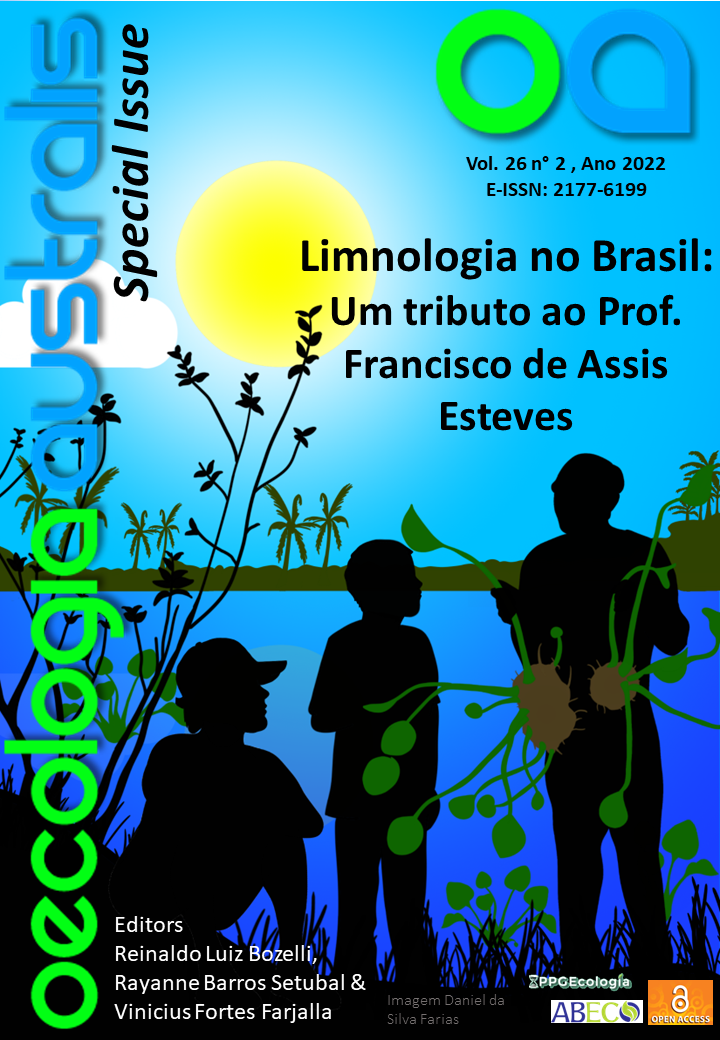A LITTLE ABOUT THE SCIENCE OF THE INLAND WATERS IN THE NORTHERN OF RIO DE JANEIRO STATE: CYANOBACTERIAL BLOOMS IN THE LOWER PARAÍBA DO SUL RIVER
DOI:
https://doi.org/10.4257/oeco.2022.2602.23Keywords:
Eutrophication, water outflow, dry period, river damming.Abstract
The 1993 inauguration of UENF (Universidade Estadual do Norte Fluminense Darcy Ribeiro) has made research on aquatic ecosystems in the northern region of Rio de Janeiro State a reality, most notably that pertaining to the lower Paraíba do Sul River (PSR) and associated ecosystems (e.g. mangroves, coastal lagoons and coastal zone). These researches were, in part, leveraged by the scientific training provided by Dr Francisco Esteves. Within the municipality of Campos dos Goytacazes, the PSR has been monitored with biweekly samplings since 1994 by UENF in a long-term project highlighting the river’s role in supplying water for 90% of the municipality’s population. However, potamological conditions such as low outflow and eutrophication have fostered episodic cyanobacterial blooms, especially during the dry season. One such event caused water supply interruptions in the municipalities located in the lower PSR basin, a fact that highlights the importance of pluriannual monitoring of its hydrochemical conditions.
References
Abonyi, A., Descy, J. P., Borics, G., & Smeti, E. 2021. From historical backgrounds towards the functional classification of river phytoplankton sensu Colin S. Reynolds: what future merits tha approach may hold? Hydrobiologia. 848(1), 131-142. DOI: 10.1007/s10750-020-04300-3
Araújo, F. G., Azevedo, M. C. C., & Ferreira, M. N L. 2011. Seasonal changes and spatial variation in the water quality of a eutrophic tropical reservoir determined by the inflowing river. Lake and Reservoir Management. 27(4), 343-354. DOI: 10.1080/07438141.2011.627753
Bonilla, S., Aubriot, L., Soares, M. C. S., González-Piana, M., Fabre, A., Huszar, V. L., Lürling, M., Antoniades, D., Padisák, J., & Kruk, C. 2012. What drives the distribution of the bloom-forming cyanobacteria Planktothrix agardhii and Cylindrospermopsis raciborskii? FEMS Microbiology Ecology, 79 (3), 594-607. DOI: 10.1111/j.1574-6941.2011.01242.x
Bonilla, S., González-Piana, M., Huszar, V., Becker, V., Somma, A., Marinho, M., Kokociński, M., Dokulil, M., Antoniades, D., & Aubriot, L. 2016. The success of the cyanobacterium Cylindrospermopsis raciborskii in freshwaters is enhanced by the combined effects of ligth intensity and temperature. Journal of Limnology. 75(3), 606-617. DOI: 10.4081/jlimnol.2016.1479
CEIVAP. 2006. Plano de Recursos Hídricos da Bacia do Rio Paraíba do Sul – Diagnóstico dos Recursos Hídricos. COPPETEC, Resende, RJ. p. 201.
CEIVAP. 2020. Relatório de Situação: Bacia do Paraíba do Sul. Associação Pró-Gestão das Águas da Bacia Hidrográfica do Rio Paraíba do Sul, Resende, RJ. p. 171.
Chorus, I., & Welker, M. 2021. Toxic cyanobacteria in water: a guide to their public health consequences, monitoring and management. CRC Press (Ed.), Boca Raton: Taylor and Francis: p. 859.
Dokulil, M.T., 2015. Phytoplankton of the River Danube: composition, seasonality and long-term dynamics. In: Liska, I. (Ed.), The Danube River Basin. pp: 411–428. Berlin: Springer.
Domingues, C. D., Silva, L. H. S., Rangel, L. M., Magalhães, L., Rocha, A. M., Lobão, L. M., Paiva, R., Roland, F., & Sarmento, H. 2017. Microbial food-web drivers in tropical reservoirs. Microbial Ecology. 73(3), 505-520. DOI: 10.1007/s00248-016-0899-1
Granado, D. & Henry, R. 2014. Phytoplankton community response to hydrological variations in oxbow lakes with different levels of connection to a tropical river. Hydrobiologia. 721(1), 223-238. DOI: 10.1007/s10750-013-1664-9
Hunt, R. J., Jardine, T. D., Hamilton, S. K., Bunn, & Stuart E. 2012. Temporal and spatial variation in ecosystem meabolism and food web carbon transfer in a wet-dry tropical river. Freshwater Biology. 57(3), 435-450. DOI: 10.1111/j.1365-2427.2011.02708.x
Kim, J.S., Seo, I.W., & Baek, D. 2019. Seasonally varying effects of environmental factors on phytoplankton abundance in the regulated rivers. Scientific Reports. 9(1), 9266. DOI: 10.1038/s41598-019-45621-1
Lima, R. N. S., Ribeiro, C. B. M., Barbosa, C. C. F., & Rotunno Filho, O. C. 2016. Estudo da poluição pontual e difusa na bacia de contribuição do reservatório da usina hidrelétrica de Funil utilizando modelagem espacialmente distribuıda em Sistema de Informação Geográfica. Engenharia Sanitária e Ambiental. 21, 139–150. DOI: 10.1590/S1413-41520201600100127676
Ovalle, A. R. C., Silva, C. F., Rezende, C. E., Gatts, C. E. N., Suzuki, M. S., & Fiqueiredo, R. O. 2013. Long-term trends in hydrochemistry in the Paraíba do Sul River, southeastern Brazil. Journal of Hydrology, 481, 191–203. DOI: 10.1016/j.jhydrol.2012.12.036
Pacheco, F. S., Miranda, M., Pezzi, L. P., Assireu, A., Marinho, M. M., Malafaia, M., Reis, A., Sales, M., Correia, G., Domingos, P., Iwama, A., Rudorff, C., Oliva, P., & Mometto, J. P. 2017. Water quality longitudinal profile of the Paraíba do Sul River, Brazil during an extreme drought event. Limnology and Oceanography. 62(S1), 131-146. DOI: 10.1002/lno.10586
Qu, Y., Wu, N., Guse, B., & Fohler, N. 2018. Riverine phytoplankton shifting along a lentic-lotic continuum under hydrological, physiochemical conditions and species dispersal. Science of the Total Environment. 619, 1628-1636. DOI: 10.1016/j.scitotenv.2017.10.139
Rangel, L. M., Soares, M. C. S., Paiva, R., & Silva, L. H. 2016. Morphology-based functional groups as effective indicators of phytoplankton dynamics in a tropical cyanobacteria-dominated transitional river-reservoir system. Ecological Indicators. 64, 217-227. DOI: 10.1016/j.ecolind.2015.12.041
Rosa, D. M. 2012. A evolução da quaidade das águas do rio Paraíba do Sul. Tese de doutorado. Faculdade de Saúde Pública. Universidade de São Paulo. p. 288.
Thorp, J., Thoms, M. C., & Delong, M. D. 2006. The riverine ecosystem synthesis: biocomplexity in river networks across space and time. Riber Res. Applic 22: 123-147. DOI: 10.1002/rra.901
Welker, M., & Walz, N. 1999. Plankton Dynamics in a River-lake System — on Continuity and Discontinuity. In: Walz N., Nixdorf B. (eds) Shallow Lakes ’98. pp. 233–239. Dordrecht: Springer.
Wu, N., Schmalz, B., & Fohrer, N. 2014. Study progress in riverine phytoplankton and its use as bio-indicator –a review. Journal of Hydrology, 1(1), 9.


